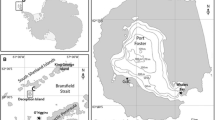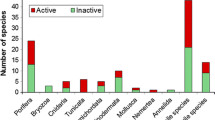Abstract
The surface of the colonial ascidianEudistoma olivaceum (Van Name) is almost completely free of fouling organisms. I provide evidence that this epibiont-free surface is maintained by the alkaloids, Eudistomins G and H. These alkaloids were extracted from colonies collected in the shallow subtidal of Indian River Lagoon, Florida. USA, in November 1987. Concentrations of less than one-fifth of those found in the living ascidian inhibited the settlement of the larvae of five invertebrate species relative to appropriate controls in laboratory and field trials. Standard pharmacological assays have revealed that Eudistomins G and H were not the most biologically active of the eudistomins, indicating that these standard assays are not necessarily good predictors of antifouling activity. In an examination of possible alternate roles for these eudistomins, they proved ineffective as a fish antifeedant. PinfishLagadon rhomboides consumed agar pellets to which Eudistomins G and H had been added at concentrations 10- to 100-fold higher than those effective against settling larvae. These findings indicate that biologically active marine natural products may serve specific ecological roles.
Similar content being viewed by others
Literature cited
Aiello, A., Fattorusso, E., Magno, S., Mayol, L. (1987). Brominatedβ-carbolines from the marine hydoidAglaophelia pluma Linnaeus. Tetrahedron 43: 5929–5932
Barthel, D., Wolfrath, B. (1989). Tissue sloughing in the spongeHalichondria panicea: a fouling organism prevents being fouled. Oecologia 78: 357–360
Blunt, J., Lake, R., Munroe, M. (1987). The stereochemistry of eudistomins C, K, E, F and L. Tetrahedron Lett. 28: 1825–1826
Davis, A. R. (1987). Variation in recruitment of the subtidal colonial ascidianPodoclavella cylindrica (Quoy & Gaimard): the role of substratum choice and early survival. J. exp. mar. Biol. Ecol. 106: 57–71
Davis, A. R., Targett, N. M., McConnell, O.J., Young, C. M. (1989). Epibiosis of marine algae and benthic invertebrates: natural products chemistry and other mechanisms inhibiting settlement and overgrowth. In: Scheuer P. J. (ed.) Bioorganic marine chemistry. Vol. 3. Springer-Verlag, Berlin, Heidelberg, New York, p. 85–114
Davis, A. R., Wright, A. E. (1989). Interspecific differences in fouling of two congeneric ascidians (Eudistoma olivaceum andE. capsulatum). Is surface acidity an effective defense? Mar. Biol. 102: 491–497
Davis, A. R., Wright, A. E. (1990). Inhibition of larval settlement by natural products from the ascidian,Eudistoma olivaceum (Van Name). J. chem. Ecol. 16: 1349–1357
Dyrynda, P. E. J. (1986). Defensive strategies of modular organisms. Phil. Trans. R. Soc. (Ser. B) 313: 227–243
Fenical, W. (1982). Natural products chemistry in the marine environment. Science, N. Y. 215: 923–928
Hay, M. E., Fenical, W., Gustafson, K. (1987). Chemical defense against diverse coral-reef herbivores. Ecology 68: 1581–1591
Jackson, J. B. C., Buss, L. (1975). Allelopathy and spatial competition among coral reef invertebrates. Proc. natn. Acad. Sci. U.S.A. 72: 5160–5163
Kinzer, K. F., Cardellina, J. H. (1987). Three newβ-carbolines from the Bermudian tunicateEudistoma olivaceum. Tetrahedron Lett. 28: 925–926
Kobayashi, J., Harbour, G. C. Gilmore, J. Rinehart, K. L. (1984). Eudistomins A, D, G, H, I, J, M, N, O, P and Q, bromo-, hydroxy-, pyrrolyl-, and 1-pyrrolinyl-β-carbolines from the antiviral Caribbean tunicateEudistoma olivaceum. J. Am. chem. Soc. 106: 1526–1528
Marchand, J. (1946). DDT as a marine fouling agent. Science, N.Y. 104: 74–75
Munroe, M. H. G., Luibrand, R. T., Blunt, J. W. (1987). The search for antiviral and anticancer compounds from marine organisms. In: Scheuer, P. J. (ed.) Bioorganic marine chemistry. Vol 1. Springer-Verlag, Berlin, Heidelberg, New York, p. 93–176
Patton, W. K. (1972). Studies on the animal symbionts of the gorgonian coralLeptogorgia virgulata (Lamarck). Bull. mar. Sci. 22: p. 419
Porter, J. W., Targett, N. M. (1988). Allelochemical interactions between sponges and corals. Biol. Bull. mar. biol. Lab., Woods Hole 175: 230–239
Rinehart, K. L., Kobayashi, J., Harbour, G. C., Gilmore, J. Mascal, M., Holt, T. G., Shield, L. S., Lafargue, F. (1987). Eudistomins A–Q,β-carbolines from the antiviral Caribbean tunicateEudistoma olivaceum. J. Am. chem. Soc. 109: 3378–3387
Rinehart, K. L., Kobayashi, J., Harbour, G. C., Hughes, R. G., Mizsak, S. A., Scahill, T. A. (1984). Eudistomins C. E. K. and L, potent antiviral compounds containing a novel oxathiapine ring from the Caribbean tunicateEudistoma olivaceum. J. Am. chem. Soc. 106: 1524–1526
Rittschof, D., Hooper, I. R., Costlow, J. D. (1988). Settlement inhibition of marine invertebrate larvae: comparison of sensitivities of bryozoan and barnacle larvae. In: Thompson, M.-F., Sorojini, R., Nagabhushanam, R. (eds.) Marine biodeterioration. Oxford & IBH Publishing Co., New Delhi, p. 599–608
Rublee, P. A., Lasker, H. R. Gottfried, M., Roman, M. R. (1980). Production and bacterial colonization of mucus from the soft coralBriarium asbestinum. Bull. mar. Sci. 30: 888–893
Scheuer, P. J. (1978–1983). Marine natural products: chemical and biological perspectives. Vols 1–5. Academic Press, New York
Sokal, R. R., Rohlf, F. J. (1981). Biometry. The principles and practice of statistics in biological research. 2nd ed. W. H. Freeman & Co., San Francisco
Sullivan, B., Faulkner, D. J., Webb, L. (1983). Siphonodictidine, a metabolite of the burrowing spongeSiphonodictyon sp. that inhibits coral growth. Science, N.Y. 221: p. 1175
Targett, N. M. (1988). Allelochemistry in marine organisms: chemical fouling and antifouling strategies. In: Thompson, M. E., Sorojini, R., Nagabhushanam, R. (eds.) Marine biodeterioration. Oxford & IBH Publishing Co., New Delhi, p. 609–617
Tursch, B., Braekman, J. C., Daloze, D., Kaisin, M. (1978). Terpenoids from coelenterates. In: Scheuer, P. J. (ed.) Marine natural products: chemical and biological perspectives. Vol 2. Academic Press, New York, p. 247–296
Wisely, B. (1959). Factors influencing the settling of the principal marine fouling organisms in Sydney Harbor. Aust. J. mar. Freshwat. Res. 10: 30–44
Young, C. M., Bingham, B. L. (1987). Chemical defense and aposematic coloration in larvae of the ascidianEcteinascidia turbinata. Mar. Biol. 96: 539–544
Author information
Authors and Affiliations
Additional information
Communicated by G.F. Humphrey, Sydney
Rights and permissions
About this article
Cite this article
Davis, A.R. Alkaloids and ascidian chemical defense: Evidence for the ecological role of natural products fromEudistoma olivaceum . Mar. Biol. 111, 375–379 (1991). https://doi.org/10.1007/BF01319409
Accepted:
Issue Date:
DOI: https://doi.org/10.1007/BF01319409




